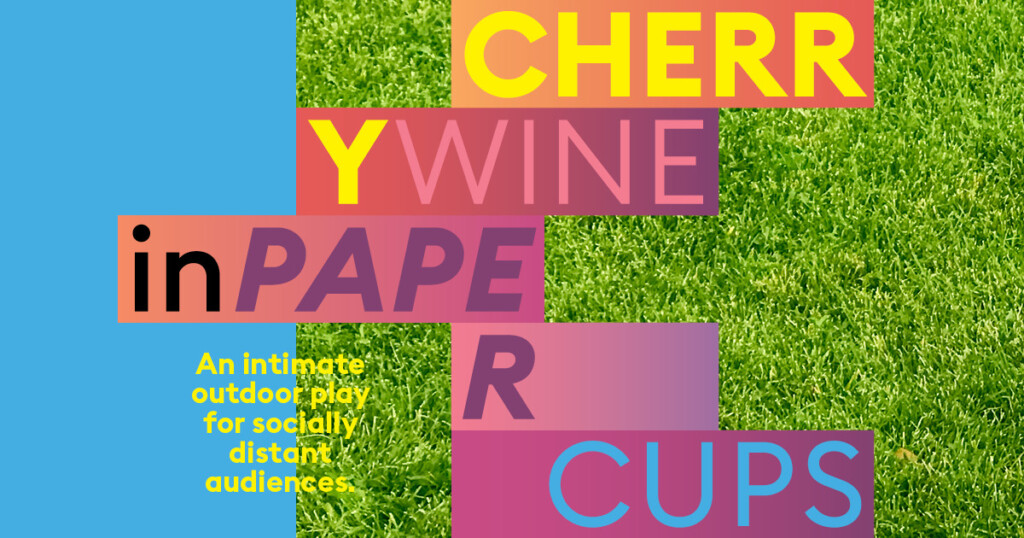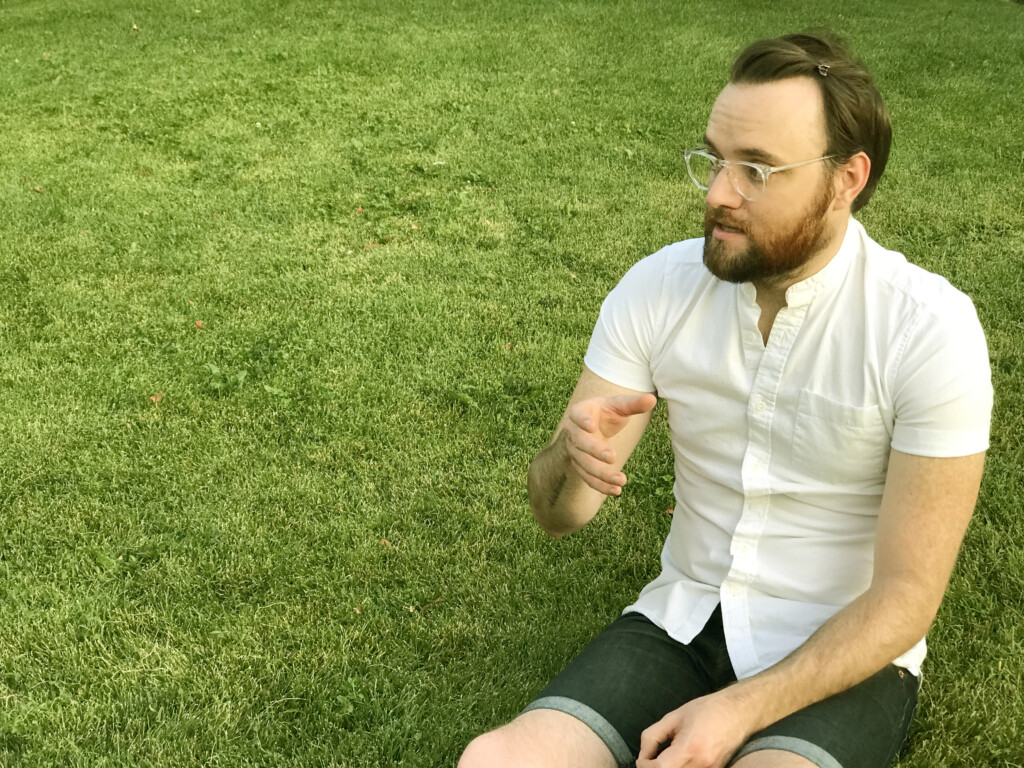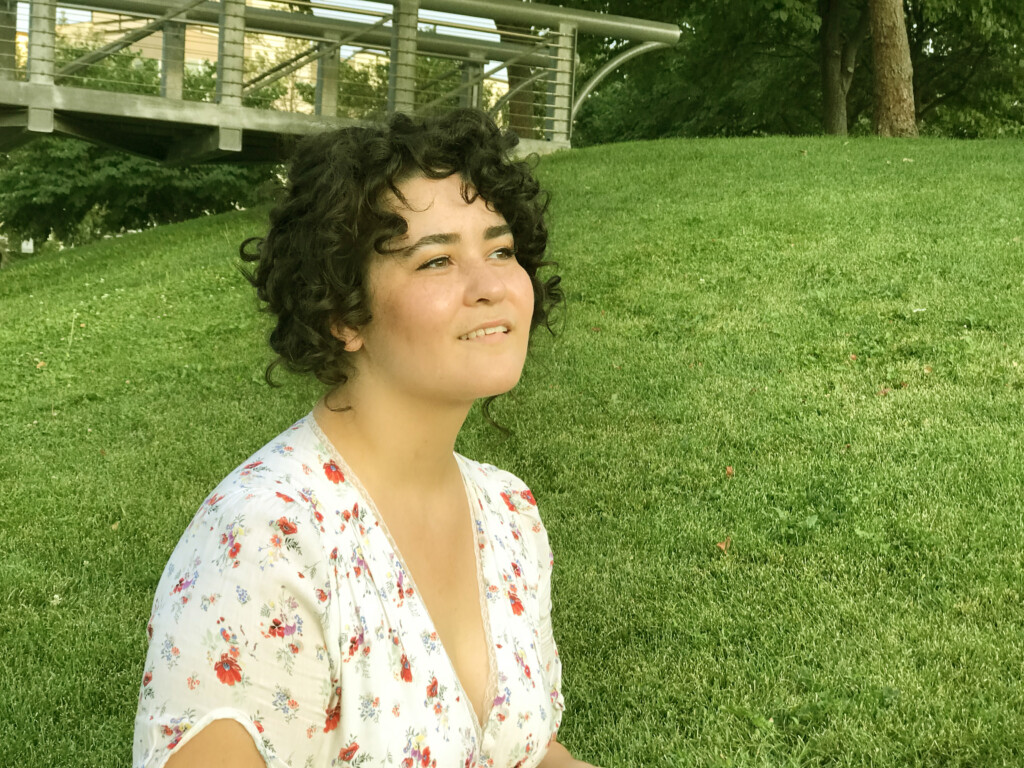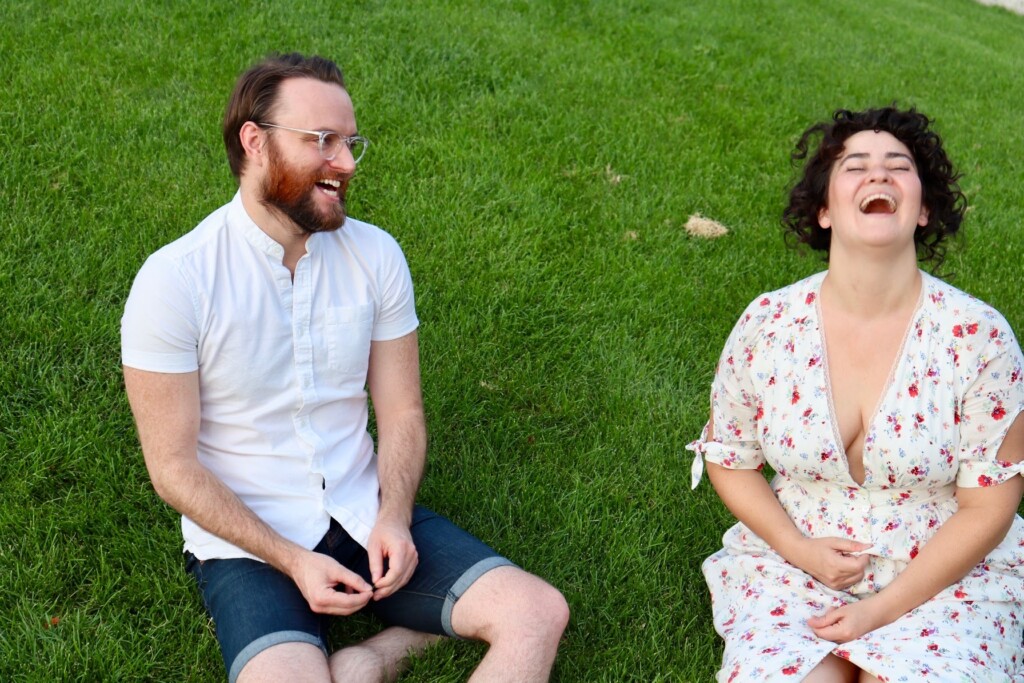Sometimes, love and romance are fantastical tales of immortal connections reignited through the experience of reincarnation. There also is the mystifying sense of love at first sight. And, then there is déjà vu, that sensation we are familiar with in our dreams but also some of us have experienced it in real life when we meet someone. However, we can become so encumbered by our masks – that is, our fears, hesitations, aversions to risk, excuses – that we resist the possibility in any permutation of reality where we accept the definitive probability that the person who appears mysteriously familiar to us when we first meet actually could be the one for meaningful and enduring romance.
These dynamics anchor a magnificent little gem, Cherry Wine in Paper Cups – an intimate outdoor play for socially distant audiences, the latest offering by Sackerson, Utah’s exceptional micro-immersive theatrical company.

Simply, this is an outstanding production in every measure. Staged in one of the loveliest areas of Library Square in the heart of downtown Salt Lake City, on the southeast corner of the plaza, the play is naturally integrated not only to the surroundings of its no-proscenium stage but also with what others might consider incidental details. For example, the one-hour play’s timing coordinates beautifully with the setting of the sun, which, of course, is becoming earlier as the autumnal equinox approaches. Cherry Wine in Paper Cups resonates with an authentic sense of place.
The audience is positioned on the lawn to accommodate social distancing measures, while everyone is afforded a clear view of the action taking place. Headsets provide the audio, including music that appropriately amplifies the mood of a particular moment in the play. The production is effortlessly natural, allowing us to replicate the experience of enjoying a pleasant evening on the lawn while observing two people awkwardly trying to decide if they are right for each other.

Likewise, playwright Morag Shepherd has delivered a fabulous script that evokes the right counterpoint of rhythms for the two characters, Taylor and Rain, as well as the narrator, a contemporary version of Eros, who claims omniscient authority on love and romance as predetermined events.
The play comprises three scenes in which Taylor and Rain meet in different circumstances with different outcomes. Shepherd’s script blends just the right hints of fantasy into an otherwise realistic, familiarly accessible story. In Utah, likely many of us already know people like Taylor and Rain. Taylor is in his early thirties. The narrator introduces him in the first scene, as Taylor sets up a motley-colored blanket at the top of a small hill and puts on music. He also is an awkward dancer. The narrator says, “The most notable thing about Taylor is that in the drudgery of everyday living, he always looks for little patches of color to bring a wash of something into his days. I’m not sure he particularly recognizes this as significant to him, it’s just something he acquires and makes space for. He collects color and moments of color like other people collect art, or cups.” Color is an invisible but consistently central character to the theme.

When Rain, who is in her middle twenties, appears, she is wearing a flowery dress. The first thing the narrator says about her is, “I’ll tell you about Rain later, but right now you should know that Rain will be the one who calls the whole thing off. You can make your own assessment, but I just didn’t want you to become attached to her or anything. You can if you want.”
In the first two scenes, in particular, the dialogue between Taylor and Rain races along at a rapid clip. Listen for the pop culture references to Buzzfeed quizzes and Game of Thrones. Their responses are terse and nervous, frequently being the first thing that pops up in their minds. They barely let any word or phrase hang in the air for a moment. There isn’t much opportunity to filter the thoughts before they are spoken. Meanwhile, the narrator is always present, sometimes at a distance or watching from the wonderfully utilized pedestrian bridge on Library Square, a testament once again to Sackerson’s successful experimentation with minimalism. His relative placement in specific moments throughout the three scenes parallels the underlying subconscious sensations Taylor and Rain try to sort through in their minds.

The second scene comprises the play’s strongest moments with astutely placed nuances of foreshadowing. The acting is superb by Shawn Francis Saunders as Taylor, Merry Magee as Rain and Harrison Lind as the narrator. Shepherd’s writing allows the actors to spread themselves artistically in an unusual outdoor setting. There are numerous moments of excellence. Taylor says, “You know how they always say that everything in life is already determined, no matter what you do, that everything is written in the heavens or whatnot? Well, my theory is, just be spontaneous, and trick them so they have no idea what you’re going to do next.” Rain challenges him, “Okay, but if that was true, they’d know that about you, and take all your options into consideration. Like, the fates or whatever probably knew that you were going to stop, and chat me up, and then try to kiss me.” Moments like these pop up in variations throughout the play. There also are critical resets within scenes, as orchestrated by the narrator, who is vigilant about maintaining preordained control.
Lind picks up beautifully on the poetry Shepherd has given him to open the second scene. Rain decides to ditch class and the professor who is trying to seduce her – “school has lost what little meaning it had.” The narrator delivers exquisitely on the natural rhythm promised in these lines: “and because of the day, that Rain thinks about trees, and how their branches are spread out and inviting, especially in the heat of the summer, especially when her head is full to the brim, and without an ounce of space for herself. Rain pauses her song and listens to the wind rustle through the leaves, and for the first time in a long time she feels a sliver of pleasure, and a hope that things have to be better.”

Produced by Shepherd, Dave Mortensen and Alex Ungerman, Cherry Wine in Paper Cups epitomizes why Sackerson has succeeded artistically in its experiments. With Mortensen and Claire Stucki directing, the production underscores Sackerson’s enviable capacity for staging naturally unfolding stories of romance in the heart of downtown Salt Lake City. Two years ago, the company staged a long, successful run of Hindsight, also written by Shepherd, in which a very small audience with headsets for each performance followed the play through various indoor and outdoor locations. For example, the play started with the production crew and audience boarding a Utah Transit Authority bus on State Street, adjacent to the Temple Square plaza. And, it ended with a beeline view of the reflecting pool and the home temple of The Church of Jesus Christ of Latter-day Saints. The company staged many performances to accommodate the logistics of handling such a tiny audience per show. Hindsight showed the vivid possibilities for a unique downtown experience.
At the time of Hindsight, The Utah Review summarized, “Rather than rely on gratuitous novelties, the company amplifies its artistic strengths with consistently good writing, acting performances that respect the integrity of the script and directing choices that prove great productions do not require expensive or extensive trappings.”
With Cherry Wine in Paper Cups, Sackerson impressively raises the bar on that assessment. This latest production, created in the midst of a stubborn pandemic that has uncompromisingly tested the capacities for resuming live performances, I would argue, is stronger than the hugely popular Hindsight show.
The production involves two alternating casts. The second includes Jesse Nepivoda as Taylor, Isabel Crews as Rain and Barrett Ogden as the narrator. It should be noted that in each cast, the characters of Taylor and Rain are played by actors who live, respectively, in the same households.

The production team includes design and photos by Dan Evans, costume by Doris Marquez, sound by Alex Ungerman, and stage management by Sam Allen.
Performances have been scheduled for Fridays, Saturdays and Sundays. The hourlong performance begins at 6:30 p.m. on the weekend of Sept. 18-20 and at 6 p.m. on the weekend of Sept. 25-27. There are performances slated through the first three weekends of October. Tickets are $25 apiece and Sackerson is offering an option for individuals on a tight budget. They may use the code “theatreforall” to obtain up to two free tickets. The company is making available 10% of tickets to anyone interested in attending the show.
The Sackerson website also provides COVID-19 social distancing requirements relative to the show. Audience members are required to wear masks on entry. Photos without flash are allowed during the performance. Audience members also are welcome to bring food to enjoy during the performance.
